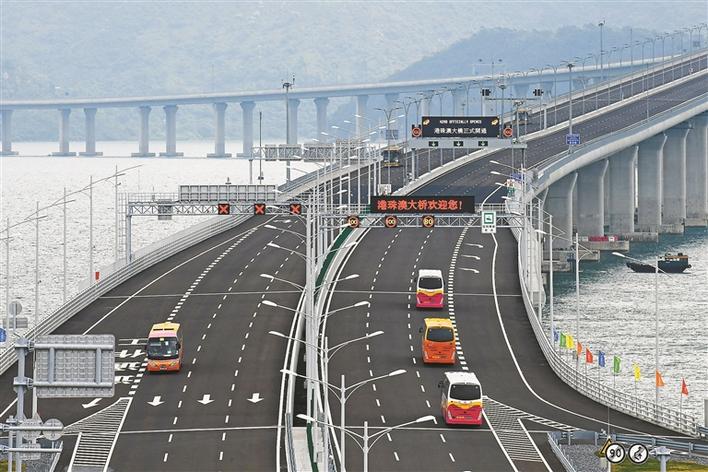World's longest cross-sea bridge opens to public
Writer: | Editor: Jane Chen | From: Xinhua | Updated: 2018-10-25

Vehicles run on the Hong Kong-Zhuhai-Macao Bridge yesterday, the first day when the world’s longest cross-sea bridge opened to public traffic. Xinhua
The Hong Kong-Zhuhai-Macao Bridge, the world’s longest cross-sea bridge, opened to public traffic at 9 a.m. yesterday.
The 55-km-long bridge connects China’s southern mainland province of Guangdong with the country’s two special administrative regions of Hong Kong and Macao.
Starting yesterday, customs in Guangdong’s Zhuhai, Hong Kong and Macao began to offer round-the-clock services for customs clearance to manage traffic on the bridge.
Both cargo and passenger vehicles pulled into driveways on the bridge via the land customs of Zhuhai yesterday morning.
Coach services also started to link the three destinations via the Y-shaped bridge the same morning. A bus or coach departing from the Hong Kong Boundary Crossing Facilities can now reach Zhuhai in about 40 minutes.
Without the bridge, drivers from Hong Kong, which faces Zhuhai across the Lingding Channel, had to detour via several cities including Shenzhen and Dongguan to reach Zhuhai and other cities in the western part of Guangdong.
Crossing the mega bridge is a bucket list experience for many residents. A Hong Kong resident surnamed Lee in his 70s was one of them. He got up early yesterday to take the first bus to ride on the bridge, only to catch a glimpse of the grand project.
Zhang Guilian, a resident in Zhuhai, said she often stays in Hong Kong. Traveling from city to city used to take her a number of car rides and ferry journeys, but the bridge will greatly accommodate commuters like her and cut travel time.
Li Meirui, marketing manager of Zhuhai Winkey Supply Chain Co. Ltd., said the bridge could have a radiating effect to Southwest China’s Yunnan and Guizhou provinces, as it connects the mainland’s highway system with the international financial and transportation hubs of Hong Kong and Macao.
She predicts a 20-30 percent growth in business volume thanks to the bridge’s traffic flow into Zhuhai’s international logistics sector, helping to strengthen her company.
Hong Kong truck driver Choy Wen-fung had his first experience of transporting goods via Zhuhai Customs before driving onto the bridge.
“All facilities are smart, such as facial and fingerprint recognition as well as infrared temperature detection. It took just one minute for a fully loaded truck to get through customs clearance. Truck drivers no longer need to work from dawn until dusk thanks to traveling by way of the bridge,” he said.
The journey between Hong Kong and Zhuhai via road used to take him nearly five hours, or a dozen hours during holidays.
Built with an investment of 126.9 billion yuan (US$18.3 billion), the gigantic project consisting of a series of bridges, artificial islands and an underwater tunnel enables smoother travel that used to be separated by channels.
With the swift new route, the economic belt of the Guangdong-Hong Kong-Macao Greater Bay Area has become a financial circle that can be looped in just one hour, uniting Hong Kong’s financial services, Guangdong’s industrial manufacturing and Macao’s entertainment industry.